SERVICES
FAQs
MRI and Bone Scans
For out-patient or in-patient appointments:
Please advise the office of your expected arrival time. Your horse can be received at anytime prior to the appointment date by arrangement with the office. Horses scheduled for imaging appointments should arrive no later than 7 am on their appointment date. Horses are typically discharged by 4 pm. Admission and discharge outside these hours is possible with advanced notice.
Most of our professional haulers have the direct clinic number and can call on your behalf.
Please see our visitation policy. You are welcome to be present during the clinical examinations. Some areas of the facility are off limits to non-authorized personnel, especially during imaging procedures. For safety reasons, handling your horse at any time while on the property is at the discretion of the doctor and staff.
Before your appointment, please make sure we have received:
Your completed and signed Authorization and Consent Form via docusign
Any pertinent medical history for review by the doctor
Any special instructions for feeding and care
Any safety instructions on handling your horse
Any specific instructions on who is authorized to receive your medical information
Your horse may be placed in an open-air stall, small, or large stallion pen, or an enclosed stall based on your preference, and considerations for a safe stay.
Your horse will be taken to a stall upon arrival. Prior to the MRI, he will have his shoes pulled (front shoes if the region being imaged is in the front limbs, hind shoes if the region being imaged is in the hind limbs), and then he will have a physical exam. A sterile catheter will placed in his jugular vein, radiographs may be taken (if needed), and your horse will be taken into the MRI room to start the scan. During the scan, your horse will be kept sedated while the scans are performed. When the scans are complete, your horse will be taken back to his stall and allowed to recover from sedation. The scans will be sent to a radiologist for evaluation and your horse’s veterinarian will review the report with you when it is received.
Your horse may be able to be picked up the same day as the scan is performed. However, we would be happy to make arrangements if your horse needs to stay overnight.
Your horse should arrive for their bone scan by 7:30 AM; the procedure takes most of the day. When they arrive, they will have their front shoes removed (depending on type of bone scan). Your horse will then have a physical exam and a sterile catheter will be placed in his jugular vein. He will be positioned in front of the gamma camera and have a radioactive isotope injected into his vein. The technician will perform the soft tissue scans that were dictated by your horse’s veterinarian. After the soft tissue images are captured, the horse will have a two hour break. Then, the technician will perform the bone phase scans. Those images will include legs, neck, back, pelvis and head, and any specific scans that your horse’s veterinarian orders. When the full scan is complete, the images will be sent to a radiologist for evaluation, and your horse’s veterinarian will review the report with you when it is received.
All horses that have a bone scan must stay overnight and can be released the following day after 1:00 PM to allow the levels of radioactive isotope to decrease to background levels. You can pick them up any time between 1:00 PM and 4:00 PM the day after their bone scan, or any time between 8:00 AM and 4:00 PM the following day.
Dentistry
Routine dental maintenance appointments by San Dieguito Equine Group involve the floating, as well as the complete balance (equilibration) of the incisors, premolars and molars of your horse’s mouth. We perform dental procedures that aid in the prevention of uneven tooth wear and the consequent development of periodontal disease and other more serious dental issues. Each dental treatment plan is based on your horse’s age, health, discipline and dental history.
What we request at the appointment:
Services
San Dieguito Equine Group proudly collaborates with a variety of consulting and referral veterinarians including radiologists, internists, surgeons, and ophthalmologists.
Equine Orthopedic Services
The lameness examination involves a combination of historical information from the client, visual examination of the horse in motion, musculoskeletal palpation and manipulation, and the alternating use of diagnostic blocking and advanced imaging to determine the source of pain or decreased performance. San Dieguito Equine Group (SDEG) provides numerous therapeutic treatments and can design a rehabilitation program specific to your horse's injury.
Comprehensive examination prior to purchasing or leasing a horse is essential for identifying underlying health conditions that may exist in the horse you are interested in buying or leasing. The pre-purchase exam is tailored to your needs and can include advanced imaging, baseline blood work and drug screening, and consultation with our boarded specialists, if requested. Pre-purchase examinations can be scheduled at our clinic or in the field; please call our office to schedule your next appointment.
Content Coming Soon!
Content Coming Soon!
Shockwave therapy is commonly used for treating lameness as a result of osteoarthritis in horses, although, it does not alter the course of the disease. Shockwave therapy expedites the healing process with soft tissue injuries such as tendonitis, suspensory strain, and lumbar myositis. Shockwave can be performed both in the ambulatory and clinic settings.
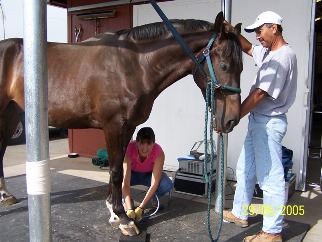
Therapeutic ultrasound is an effective treatment for both chronic and acute injuries. Therapeutic ultrasound machines work by converting electrical current into high-frequency acoustic energy waves. Ultrasound waves can travel one to five centimeters into the body’s soft tissues. The penetrating waves allow heat to travel further into the patient’s tissue. This allows for small vibrations of cells to change the tissues permeability and diffusion rates. As a result, inflammation, bruising, and healing time decrease. Thus, the horse experiences a more comfortable recovery period. San Dieguito Equine has multiple therapeutic ultrasound machines that are available for weekly or monthly rental.
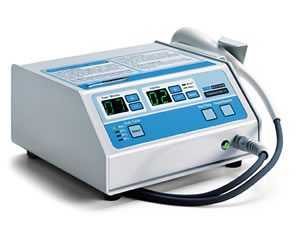
The use of IRAP is an effective intra-articular treatment for joint disease. The IRAP system is designed to stimulate the horse's own white blood cells to produce anti-inflammatory mediators and enzymes. These mediators and enzymes reduce inflammation caused by degenerative joint disease. Initially, the patient's blood sample is collected and brought to our clinic for incubation (24 hours) and processing.). After processing, the IRAP is ready to be used. However, additional doses may be stored at our clinic for up to one year. The injection process is typically done under sedation at the patient's field location. When injected into a joint, the protein-rich serum stimulates a regenerative response from cartilage cells, through a process of cell division and increased cell recruitment. This gives IRAP a disease-modifying component and an anti-inflammatory component. The serum also contains cytokines that act to reduce inflammation within the joint. In addition, there are other anti-inflammatory proteins produced during the incubation process that work synergistically with the cytokines to further reduce the inflammation within the diseased joint.
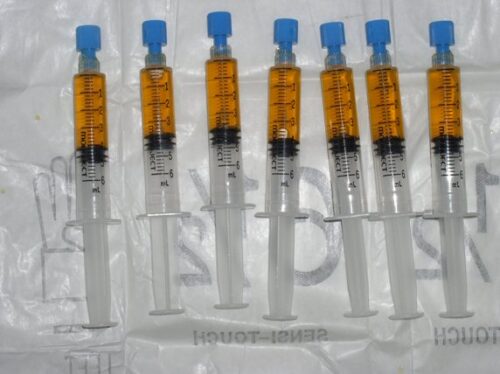
PRP is regularly used to treat tendon and ligament injuries. The collection and preparation of platelet rich plasma is simple, non-invasive, and only takes about thirty minutes. Blood is collected from the horse's jugular vein and processed. The platelet rich portion is then collected and injected into the lesion. The use of PRP has been show to expedite the healing process.
Stem cell therapy is commonly used for tendon and ligament injuries. Stem cells are undifferentiated (not specific to a certain tissue type) and thus, they have the potential for mass replication. This feature allows stem cells to differentiate into various types of cells in response to the region that they are injected into. The process of harvesting stem cells includes sedating the patient and collecting bone marrow from the sternum. The bone marrow and nutrient-rich serum that is collected and then sent to the laboratory for isolation and culture. The laboratory process of culturing stem cells results in a significant increase in the number of concentrated stem cells. Culturing of stem cells typically takes about seven to ten business days. Then, the stem cells and serum can be injected into the patient (at the injury site). Typically, the injection is done under ultrasound guidance to ensure accurate delivery of the stem cells to the injury site.

Advanced Diagnostic Imaging
Magnetic Resonance Imaging (MRI) uses strong magnetic fields and radiofrequency pulses to produce detailed images of bone structures and soft tissue. Our low-field system allows us to acquire images of the distal limb in the sedated, standing horse. In comparison to general anesthesia, standing sedation allows for faster anesthesia recovery and drastically reduces the risk of injury. During the MRI, we gather images in multiple planes, which allows the radiologist to precisely locate the cause of the issue. Depending on the temperament of the horse, the exam takes between three and five hours MRI allows us to diagnose lameness or injuries that may not be apparent via other imaging techniques such as radiography or ultrasound. For more information about what to expect during your horse’s MRI at our clinic, please refer to our MRI Frequently Asked Questions page.
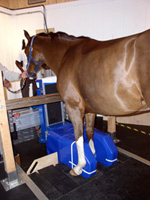
Nuclear scintigraphy, commonly known as a "bone scan,” or "NUC” is a diagnostic procedure used in lameness cases. An intravenous radiopharmaceutical (Technetium-99) is administered to the horse. Then, the horse is returned to its stall. While in the stall, the radiopharmaceutical accumulates in areas where bony remodeling is actively occurring. A specialized camera delineates areas of increased radiopharmaceutical uptake (indicating injury) in comparison to uptake in healthy tissue. This type of imaging is especially useful for diagnosing injuries that are difficult or impossible to visualize with radiographs or when the horse has multi-limb lameness. The imaging process takes approximately six hours to complete and an overnight stay is required to ensure elimination of the radioactive isotope from the horse’s system. For more information about what to expect if your horse has a bone scan at our clinic, please see our Frequently Asked Questions (FAQ) page.
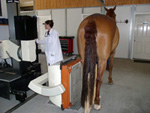
Digital radiography (DR) allows for detailed diagnostic studies of bone pathology. San Dieguito Equine Group utilizes state-of-the-art portable DR systems in our practice. Each ambulatory vehicle is equipped with a portable DR system allowing for our veterinarians to acquire radiographs in the field without delay. Preliminary review of the images can take place in the field; however, final interpretations are made on high-resolution monitors at our practice. San Dieguito Equine also has an in-house DR system for clinic appointments. All images are archived to a cloud-based server and can be emailed to owners or consulting veterinarians.
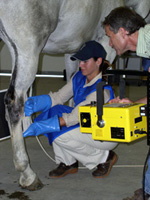
Ultrasound is a valuable imaging tool used to visualize soft tissue structures in the horse. Joint, tendon, and ligament injuries can be diagnosed and monitored using this modality. It also allows for evaluation of thoracic and abdominal organs for horses with suspected systemic illness. San Dieguito Equine has ultrasound units in each ambulatory vehicle and at the clinic. All images are archived to a cloud-based server and can be emailed to owners or consulting veterinarians.
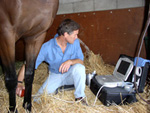
Endoscopy and gastroscopy are important tools for evaluating a horse’s upper respiratory tract and stomach. Endoscopy aids veterinarians in investigating respiratory issues such as coughing or chronic nasal discharge. Evaluation of the upper respiratory tract is possible in the field. Sedation is not required for endoscopy procedures. Gastroscopy is used to accurately diagnose stomach ulcers, which can cause signs of colic, weight loss, and poor performance. The horse is fasted prior to the procedure and sedation is required. The horse may return to their normal routine shortly after they recover from sedation. Currently, the procedure is primarily performed at our clinic. In the near future, San Dieguito will be able to perform gastroscopies in the field.Both scoping instruments are equipped with a monitor that allows our veterinarians to visualize key anatomical structures during examination. Portable and video devices are available at San Dieguito Equine’s clinic. Recording capabilities allow our veterinarians to save images for medical records or for outside consultation.
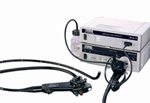
Thermography utilizes a specialized camera to detect infrared waves, which cannot be seen by the human eye. For visualization purposes, the camera converts the waves to an image called a thermogram; the thermograph delineates areas of increased or decreased heat. Increased heat indicates increased circulation which can be correlated with inflammation. In contrast, cooler regions may indicate tissue scarring, reduced circulation, or disrupted nervous system conduction. A change in one degree between two comparative regions is considered abnormal. Thermography is useful for diagnosing lameness, saddle-fitting issues, and monitoring healing. The procedure is noninvasive, does not require harmful radiation, and is well tolerated by horses.
Equine Wellness Management
Acupuncture involves the placement of thin, sterile, stainless steel needles at specific points on the body where nerve bundles penetrate fascia, in close proximity to major blood vessels that are surrounded by small nerve bundles, and where nerves enter or exit muscles. Insertion of acupuncture needles (dry needling) results in a local and systemic response by the nerves in the region. Local effects cause the release of anti-inflammatory responses, improve circulation, and activate the immune system and tissue repair. Acupuncture is performed by a veterinarian certified in veterinary acupuncture. Acupuncture is used to treat acute and chronic musculoskeletal injury, improve the general well being of athletic horses, and provide additional systemic support for horses suffering from a broad range of medical conditions, such as gastrointestinal, kidney, liver, or lung disease. Dr. Brett Robinson of San Dieguito Equine Group is a Certified Veterinary Acupuncturist. Please call our office to schedule your horse’s next acupuncture appointment with Dr. Robinson.
Veterinary chiropractic work focuses on maintaining and restoring the health of your horse's nervous system through identifying vertebral subluxation complexes and performing the appropriate adjustments in the spinal column or extremities. Your horse will be examined in static and dynamic motion. The veterinarian’s hands are used to assess the amount of motion/restriction in joints, spasm of muscles, flexibility, asymmetry, etc.
When a joint is found to have decreased motion, a specific, low amplitude, high velocity thrust (i.e. adjustment) is performed. This restores appropriate communication between nerves in the nervous system. Veterinary chiropractic work may be used as an integrative treatment for musculoskeletal conditions, such as back, sacroiliac, and neck pain. Depending on your horse's history and examination, a period of rest may be recommended after treatment. A plan for future examinations will be discussed at the appointment, if needed. Some equine athletes are maintained on a monthly schedule while others may be examined once to twice yearly.
Dr. Rebecca James performs chiropractic work at San Dieguito Equine Group. She completed training for Veterinary Chiropractic at Options for Animals and was certified in Veterinary Chiropractic by the International Veterinary Chiropractic Association.

Please call our office immediately if you suspect that your horse may have an problem with their eye(s) or vision. We consider all ophthalmology issues as possible emergencies. Time is of the essence; the sooner a diagnosis is made along with a treatment plan, the higher the chances of a successful outcome. Board certified ophthalmologists are also available for advanced ophthalmology cases. Consultations can be scheduled at our clinic in San Marcos, CA.

Annual dental examinations and routine dentistry are essential to early recognition and management of dental problems that can affect digestion, body weight, and performance. San Dieguito Equine Group provides power dentistry based on individual horses' needs to correct dental abnormalities and for preventative maintenance. For more information about what to expect when your horse receives dentistry, please see our dentistry Frequently Asked Questions (FAQ) page.
General wellness management is essential to maintaining your horse’s health and performance. San Dieguito Equine Group is committed to providing general services such as vaccines, deworming, nutritional consultation, annual examinations, insurance examinations, Coggins testing, and travel certification. Our highly dedicated team would be happy to create an individualized wellness plan for your horse.
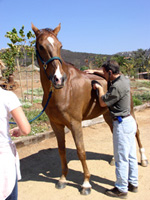
Referring Veterinarians
When referring one of your patients to our clinic for imaging, consultation, or surgery, we would appreciate receiving the following information from you:
Externs / Interns
Our practice is committed to making a difference in our profession by encouraging and training the next generation of equine practitioners. Several of our veterinarians have additional training in leadership development and veterinary education. In keeping with our desire to teach and develop students interested in equine veterinary medicine and surgery, we offer veterinary student externships throughout the year.
These externships are available to current veterinary students and recent veterinary school graduates only. Because we are involved with training veterinary students from multiple universities, time slots fill up quickly. If you are interested in completing an externship at our practice, please contact our office for scheduling information.